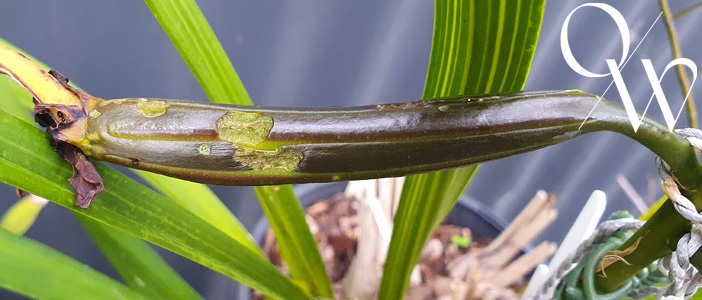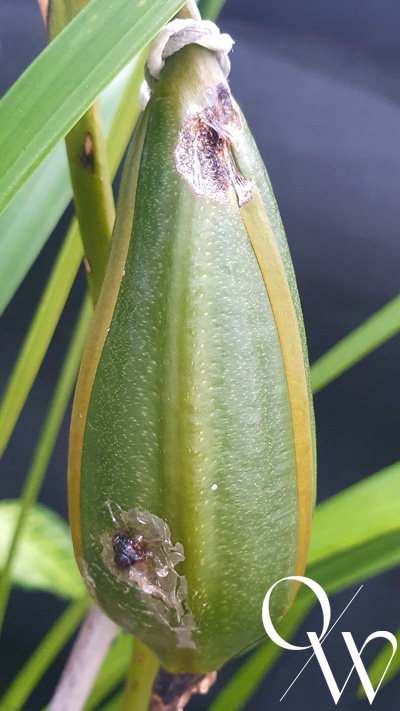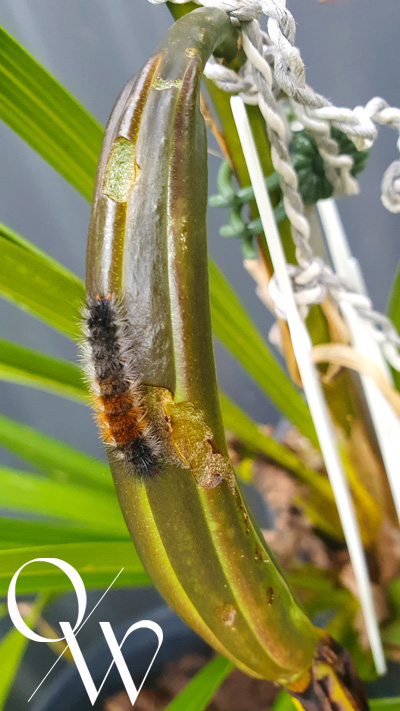Every now and then we take a walk through the Orchid Wise Shade House to see what has been flowering or what else of interest might be happening. The Orchid Wise shade house is overflowing with all sorts! From species and primary hybrids to modern show bench hybrids and everything in between. You just never know what you’ll find! And this week it’s Cymbidium orchid pests…..

For anyone trying their hand at hybridising, you will know it can sometimes be a long and frustrating process. It is certainly a patience game! There are just so many things that can go wrong………

Firstly, having to wait until the right plants flower to even start the pollination process. Any of the following could then happen after that – having a failed pollination attempt, having a seed pod abort part way, having a seed pod knocked off the spike, breaking a spike or having the seed pod eaten by something. And then having to wait a year or more until the right plants flower again to give it another shot.
The key is keeping a very close eye on your pods. Almost daily really. I’m in my shade house every single day. Spending as much time in the shade house as I do makes you notice things, in detail. And the good thing is you notice things very quickly. You notice if a plant has been moved, is starting to look malnourished, or under-watered, stressed or if it is showing signs of virus, or if something is eating your seed pods!
So today whilst walking through the shade house, what do I see……..damage to a few of my seed pods.
In this case something had certainly munched on them, but what? Because I’ve never had anything eat them before…..
What’s eating my seed pod?
It took a little while to get around all of my plants holding seed pods to check them, and I found quite a bit of damage. But I finally managed to find the culprit. And yep, I have a common orchid pest – caterpillars……..for the first time ever. And wasn’t I a tad bit annoyed!
The photos here are all from my plants and show the damage Caterpillars can do.
Without a doubt I have Tiger Moths, or what are generally known in Australia as Wooly Bear’s……
A few small caterpillars have managed to cause quite a bit of damage in what must have been just a few days…… Thankfully those I did find were quite small, and they were dispatched quickly!

It’s still too early to tell they have eaten into the pod far enough to cause any real damage, but it’s highly possible, jeopardising my hybridising efforts and possibly my future plans. They can do a lot of damage very quickly.
So, how do we get rid of them?
To start with, I have squashed the caterpillars I did find, so they won’t be a problem any more!
So what’s next? Spraying to get rid of any I couldn’t see.
Dipel is one product you can use. It is a a biological control, which works well, but needs regular application, because it washes off easily. To treat, try Yates Nature’s Way Caterpillar Killer. Usually purchased in a spray bottle, it is based on naturally occurring bacteria (Bacillus thuringiensis) which acts as a stomach poison against caterpillars. The product will only affect caterpillars, so your ‘good bugs’ are safe.
Another is Bacillus thuringiensis or BT. It’s a bacterial bio-control that paralyses caterpillar guts when they ingest it. It’s effective on a range of caterpillars, particularly when they’re young. Mix it by following the directions on the pack. Spray thoroughly and re-apply on a weekly basis until the population drops off.
Stay Vigilant & Monitor Your Plants
Paying careful attention to what’s going on with your plants will save you a lot of frustration. Caterpillars are a common orchid pest. They love to eat flower spikes, flower buds and seed pods, so get to them before they get to you!
